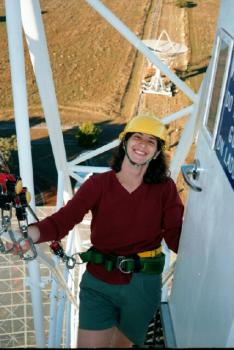This is the unofficial website of the NSF AAPF program, run by the fellows themselves. For official information about the fellowship, please go to the NSF program announcement.
Jessica Rosenberg

Much of my scientific background has been in the studies of galaxies at 21cm, the near infrared, and the optical with particular emphasis on the statistics of galaxy populations in the local universe. My thesis work was a census of gas-rich galaxies in the local universe to get a handle on whether these systems have been under-represented in optically selected samples. We found a high fraction of dwarf and low surface brightness galaxies, but the HI in these systems does not contribute a significant amount to the missing baryonic matter. However, these nearby gas-rich systems may provide an important glimpse at how galaxy evolution has progressed and continues to progress today.
More recently I have been studying the physical properties of Lyman-alpha absorbers. These systems represent a method of studying gas in the universe over a huge range in density from that of galaxies, the damped absorbers, to the tenuous intergalactic gas. I am particularly interested in the connection between the Lyman-alpha absorbers and galaxies. The Lyman-alpha absorbers may provide a way to study the gas in galaxies, their halos, and in intergalactic space. Because the metal lines are also observable, these systems can be used to differentiate between pristine infalling gas and the metal-enriched material expelled from galaxies due to star formation and galactic winds.
Lyman-alpha absorbers are excellent tracers of galaxy halos and the lowest redshift gas. With COS, the next spectrograph on HST, we will be able to study galaxy halos in detail, examining the extent of the halos and the propogation of metals through them. These studies will, for the first time, enable us to statistically study the connection between the Lyman-alpha forest and galaxies at a redshift where we can study the galaxy populations in detail.
I am very interested in how astronomy can be used to introduce science to students in a fun and exciting way. I am presently involved in a couple of different teaching and outreach projects.
For the Science Explorers program, a teacher development program run by the University of Colorado, I have designed a curriculum on galaxies for 5-8th grade students. The curriculum consists of background material as well as activites, and observation questions. I will travel to several schools during the fall of 2003 for teacher workshops where I will present the material. The workshops are set up for teachers to come with 4-5 of their students and spend an hour and fifteen minutes running through each curriculum. The forum provides an opportunity for the teachers to see their students run through the material and gives an opportunity to the students to act as leaders when the material is presented in their classroom.
I am also involved in a reform of introductory astronomy with the goal of making a large lecture class more interactive. One of the pieces of the reform is to use undergraduate learning coaches (students who have taken the class before, done well, and show interest in becoming science teahers) to help facilitate discussions between small groups of students. The additional goal of this course is to recruit, support, and prepare University of Colorado undergraduates to become leaders in K-12 science and math education. This course reform is taking place across several of the science and math deparments at the University of Colorado and is supported, in part, by a grant from the National Science Foundation, STEM Colorado.